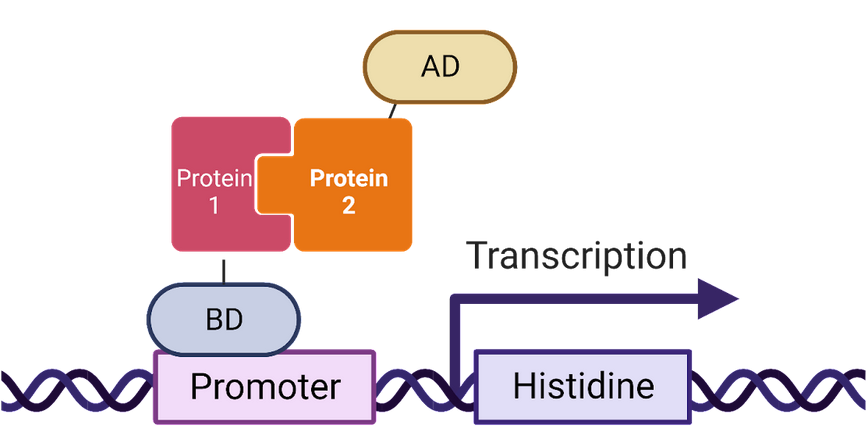By Chelsea Smith
Fun Rating: 3/5

Difficulty Rating: 2/5

What is the general purpose?
Yeast-two-hybrid screens are used to determine if two proteins interact, or come in contact with each other. When scientists study a protein, this experiment is used to help them determine what other proteins it can interact with, giving insights to how it may work in a cell.
Why do we use it?
Protein-protein interactions, or contact between proteins, can provide information about a protein’s role in cells. Scientists study protein-protein interactions to uncover biological pathways, such as ways our cells repair their DNA, or to understand why a protein may be more abundant in cancer patients. A yeast-two-hybrid screen allows scientists to check for these protein-protein interactions quickly and with low cost. Other experiments to check for protein-protein interactions are often costly and time consuming. Yeast is easy to grow and easy to work with, making it a great choice to use for experiments.
How does it work?
Scientists begin a yeast-two-hybrid experiment by creating plasmids, or circular pieces of DNA. In this plasmid, there will be the genetic code, or instructions, for the protein they are studying, connected to either a binding domain (BD) or activating domain (AD). The BD and AD are what will help the scientist determine if the two proteins interact. The two plasmids are put into yeast cells, and the yeast cells will then generate the proteins the plasmids code for. One protein of interest will be produced with the BD, and the other will be produced with the AD.
Once the proteins attached to either the BD or AD are produced, if the two proteins interact, this will bring the BD and AD close to one another. When the BD and AD are close to one another, they are able to activate their target promoter. A promoter is a region of DNA that, when activated, can turn on the production of a gene. Without the BD and AD both being present at the promoter, the gene will not be produced.

Image generated by the author using BioRender. The BD, bound to Protein 1, attaches to the promoter. When Protein 2 interacts with Protein 1, this will bring the AD close to the promoter as well, and allow for the production of a gene, in this case Histidine.
For a yeast-two-hybrid experiment, scientists have created a strain of yeast that cannot make the amino acids it needs to survive. This means it will not grow if these required amino acids are not provided by the scientist. Yeast is typically grown on a special plate containing a substance called agar. The scientist can control what amino acids are present in the agar plate. The gene produced when the two proteins interact codes for one of these essential amino acids, for example, histidine. In this case, when yeast are put onto plates that don’t have histidine in them, they will only grow if the two proteins interact and produce histidine. Therefore, growth of yeast on these plates indicates a protein-protein interaction.

Yeast grown on agar plates. Image Source
Although yeast-two-hybrid screens have mostly been used to identify protein-protein interactions, they have also been adapted to look at interactions between protein and DNA, and protein and RNA. Yeast-two-hybrids have contributed to major scientific discoveries, and even some which impact human health and how we treat disease. One example includes studying the protein-protein interactions of p53, which is mutated in about half of human cancers. When scientists studied this protein using yeast-two-hybrid experiments, they found it interacts with a protein called MDM2. Now, there are clinical trials to test whether treating patients with drugs that inhibit MDM2 will help to get rid of their cancer.
Although yeast-two-hybrids are one of the simpler experimental techniques to study protein-protein interactions, they have proven to be powerful and led to major scientific discoveries.
